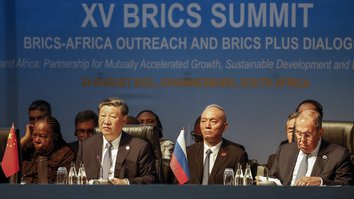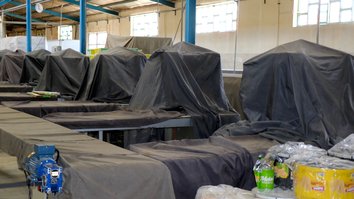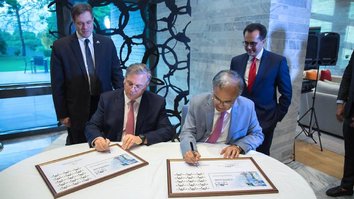Among the many crimes and atrocities the Iranian regime has been complicit in since the start of the Syrian civil war in 2011, the exploitation of young Afghans and Pakistanis to advance Iranian goals in the conflict is perhaps one of the most heinous and least understood.
Iran's Islamic Revolutionary Guard Corps (IRGC) funds, trains and equips the Fatemiyoun Division -- a militia made up of Afghans -- and the Zainabiyoun Brigade -- a militia made up of Pakistanis.
Thousands of Afghan and Pakistani fighters have been reported killed and wounded in combat in Syria over the years, mostly in operations supporting the regime of President Bashar al-Assad, a close Iranian ally.
Since the early days of the Syrian civil war, IRGC operatives have employed a mix of ideology, financial incentives and coercion to recruit Afghans and Pakistanis as little more than cannon fodder for Syrian battlefields.
![Members of the Fatemiyoun Division participant in a mourning ceremony in Aleppo, Syria on October 17. [File]](/cnmi_pf/images/2020/10/23/26705-aleppo-585_329.jpg)
Members of the Fatemiyoun Division participant in a mourning ceremony in Aleppo, Syria on October 17. [File]
IRGC recruiters promise that the young men would defend sacred Shia shrines and receive hefty salaries and Iranian citizenship.
The reality, however, is much different.
Preying on the vulnerable
In February, Pakistani security personnel arrested several individuals in Karachi whom they suspected of being affiliated with the Zainabiyoun Brigade and other Shia militant groups active in Pakistan and abroad.
Subsequent investigations confirmed their affiliations, highlighting the recruitment of vulnerable Pakistani Shia by IRGC recruiters from various parts of the country including Karachi, Quetta, Peshawar and Parachinar, according to reports.
While the IRGC might have recruited hundreds of young Shia from within Pakistan for the Zainabiyoun Brigade, reports indicate that over time, the organisation has shifted its focus on recruiting Pakistani Shia who travel to Iran for pilgrimage or work.
This transition is likely due to a series of crackdowns by Pakistani security forces on Iran-linked Shia militant groups, which the government views as a threat to national security.
Regardless of location, IRGC recruiters seem mostly to target vulnerable Shia youth, who often struggle with poverty and unemployment.
In many cases, these young men are detained while visiting Iran and placed in special prisons where their jailers brainwash and coerce them into joining the Zainabiyoun Brigade.
The large number of Afghan refugees in Iran has provided IRGC recruiters easy access to a population of impoverished and often desperate young men.
Over the years, numerous reports have emerged of IRGC operatives coercing young Afghans -- in many cases children -- to join the Fatemiyoun Division or face deportation, along with their families.
As with Zainabiyoun recruits, these youths are fed false promises of impressive salaries, Iranian citizenship and other benefits.
This blatant exploitation of Afghan refugees by Tehran has drawn widespread condemnation by regional and international observers, who note that this vulnerable population often has little choice but to comply with the demands of IRGC operatives.
Even the Afghan government has taken note of the Iranian regime's exploitation of Afghan refugees and called for disbanding the Fatemiyoun Division.
Moreover, Afghan defence officials and civil society activists have expressed alarm over the activities of returning Fatemiyoun members who pose a significant threat to security and stability in the war-weary nation.
A gathering in August of Fatemiyoun members in Mashhad, Iran, increased concern because its participants made provocative statements indicating that the group would soon expand its activities into Afghanistan and neighbouring countries.
Broken promises
While estimates vary and are difficult to verify, most observers agree that the number of Fatemiyoun and Zainabiyoun combatants killed and injured in Syria -- many of them minors -- ranges in the thousands.
Many of the dead fighters have been buried in mass graves in Syria and Iran, leaving grieving families in Afghanistan and Pakistan to wonder about the fate of their sons, indicate some reports.
Unfortunately, the exploitation of vulnerable Afghans and Pakistanis by the IRGC does not appear to end even after their deaths on Syrian battlefields.
Over the years, Tehran has shamelessly paraded the children of dead militants in carefully orchestrated ceremonies meant to lure more young Shia men into the Fatemiyoun, Zainabiyoun and other IRGC-linked militias.
In reality, the families of dead and wounded militants receive little to no support from Iran -- a fact that emerges in countless interviews with regional observers and the families of Afghan and Pakistani fighters.
In most cases, promises such as housing, financial assistance and Iranian citizenship for the families of dead militants have gone up in smoke, leaving countless grieving widows and children to fend for themselves.

![Onlookers near the Imam Reza shrine in Mashhad, Iran, on October 15 look at posters of Fatemiyoun members killed in Syria. [File]](/cnmi_pf/images/2020/10/23/26706-martyrs-585_329.jpg)







Iran is, in fact, the greatest ideological and geographical enemy of the Islamic world.
Reply1 Comment(s)